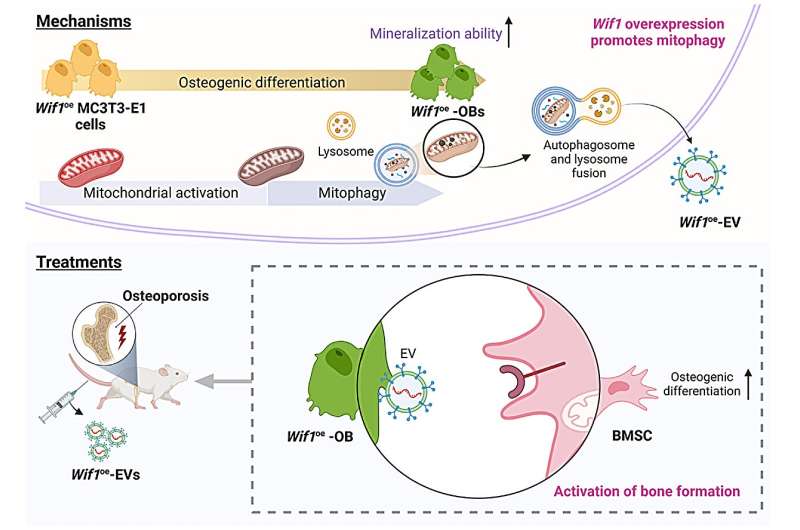This article has been reviewed according to Science X's editorial process and policies. Editors have highlighted the following attributes while ensuring the content's credibility:
fact-checked
trusted source
proofread
Osteoblast-derived extracellular vesicles exert bone formation effects by WIF1-mediated regulation of mitophagy: Study

Osteoporosis is a common disorder, especially in the elderly, characterized by bone loss and increased fracture risk. Treatments target abnormal osteoclast activity but face adherence issues. The disease disrupts the balance between bone resorption and formation. Key factors like Wnt signaling and mitochondrial health influence osteoblast differentiation. However, WIF1's role in regulating mitophagy and osteoblast differentiation remains unclear.
A recent study, published in the journal Medicine Plus, investigated the role of WIF1 in controlling the osteogenic differentiation stage of the OB precursor cell line (MC3T3-E1 cells) and assessed its potential therapeutic impact on osteoporosis.
Utilizing transmission electron microscopy (TEM), Wif1 was identified as a crucial gene that regulates late-stage osteogenic differentiation through the activation of mitophagy. Furthermore, Wif1-overexpressing OB-derived extracellular vesicles (EVs) with bone-targeting potential were injected into ovariectomized (OVX) mice to evaluate their potential therapeutic effects in osteoporosis.
First, the study investigated the role of Wif1 in osteoblast (OB) differentiation and its therapeutic potential for osteoporosis. Using MC3T3-E1 cells, the researchers found that Wif1 expression increased significantly during the terminal stage of OB differentiation, indicating its role as a marker gene in regulating osteogenesis. Knockdown of Wif1 reduced mineralization and osteogenic potential, while Wif1 overexpression enhanced osteogenic differentiation. Furthermore, Wif1 overexpression activated mitophagy, as evidenced by increased autophagosome formation around mitochondria.
The study also explored the therapeutic potential of EVs derived from Wif1-overexpressing OBs. These EVs significantly promoted osteogenesis in bone marrow mesenchymal stem cells (BMSCs) in vitro and demonstrated bone-targeting capabilities in vivo.
In a mouse model of osteoporosis induced by ovariectomy, treatment with EVs derived from Wif1-overexpressing OBs reversed bone loss, highlighting their potential as a therapeutic intervention for osteoporosis. These findings underscore the significance of Wif1 in bone biology and suggest its potential as a therapeutic target for osteoporosis.
Taken together, the findings provide experimental evidence that Wif1 promotes the osteogenic differentiation of MC3T3-E1 cells and that Wif1oe-OB-derived EVs ameliorate osteoporosis. The therapeutic significance of Wif1 lies in its indirect impact on the Wnt signaling pathway, thereby not affecting the normal osteogenic differentiation of cells. By obtaining Wif1oe-OB-derived EVs with osteogenic-promoting functions, effective treatment of osteoporosis could be achieved, representing a potential clinical therapeutic strategy.
More information: Yuyuan Gu et al, Osteoblast-derived extracellular vesicles exert bone formation effects by WIF1-mediated regulation of mitophagy, Medicine Plus (2024). DOI: 10.1016/j.medp.2024.100033




















